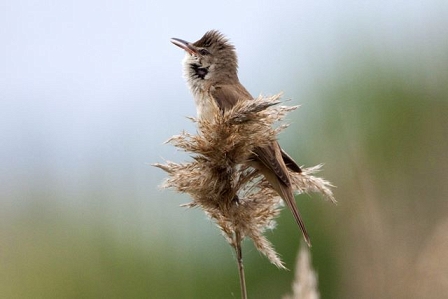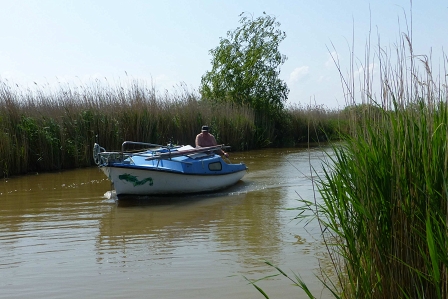Erstellt am: 5. 6. 2014 - 14:08 Uhr
All Dried Out?
Austria is much celebrated for its spectacular mountain scenery, but this country is also home to fabulous wetland areas. Less appreciated, they are also more threatened.
To mark our FM4 Into The Blue focus on water issues, I took a bike ride around Lake Neusiedl to explore parts of this fragile paradise that bring a taste of Central Asia, East Africa and the Black Sea, all within a few kilometres of the capital Vienna.
If you care about biodiversity, Lake Neusiedl is a watery wonderland. But after thousands of years as a haven to wildlife the unique character of the lakes is now severely under threat. The demands of agriculture, the leisure industry and settlement mean ecosystems that have survived millennia might be wiped out within a generation.

Michael Dvorak_ BirdLife
My first stop was the Seewinkel National Park where sometimes, in the early morning, you can see thousands of geese taking off simultaneously before sunset like a massive squadron of planes. The national parks are home to soda lakes – pools really, or Lacken in German, that harbour mysterious life forms.
“They are incredible because they have this unusual chemical makeup that creates conditions for unusual organisms,” says Bernhard Kohler of the WWF.
 WWF_Franziska Werba2-_body.jpg)
WWF_Franziska Werba
Below the milky surface of the water, you’ll find mysterious fairy shrimp as well as other tiny crustaceans and larvae that you would usually only see in the steppes of Central Asia.
These salty snacks attract birds to the area usually only found in coastal areas, like Pied Avocet - known in German as the Säbelschnäbler. Migratory birds make a stop here to take advantage of the salty conditions.
A hundred years ago there were 140 of these soda lakes, or Salzlacken, but only around 40 still exist today. They are drying out at an alarming rate: "If we don’t reverse the trend" says Bernhard Kohler of the WWF, "within a generation they will have disappeared." This would be a tragedy. The soda lakes have been here for 20,000 years.
They are formally protected by the rules of the national park, which was created in the early 1990s, but a century long completion for water is still being felt, says Kohler.
To make Burgenland fit for agriculture, people dug drainage channels to dry out the land and then other channels to irrigate the water in a more controlled way.
Farmers, understandably, wanted to use the swampy land for lucrative crop harvests or for viniculture. The Hanság, for example, is an area which was once under the shallow waters of the lake but is now used to grow crops. In the years running up to the First World War a small canal was dug from the southern end of the lake to the nearby Rabnitz River.
Predictably the engineering which brought wealth to the area had an adverse effect on the health of the wetlands.
The soda lakes need a high water table to replenish their natural salt content, says Kohler. “We need the water to be only a few centimetres below the surface of the ground so salt can be transported through the earth into these pools.”
Kohler says that to restore the health of the soda lakes some reverse engineering will be needed to re-raise the groundwater to their previous levels. It will be a delicate task since houses have been built in former flood areas and their foundations would be threatened by any changes. But Kohler is confident that a solution can be found and that the water levels can be raised. He believes that with modern expertise and precise measurements a balance can be found that will allow the soda lakes to survive without destroying livelihoods - hydrological models can be used to determine how the drainage channels can be closed without damaging settlements.
 Mario Romulic_romu_body.jpg)
Mario Romulic
The replenishment of water has to be done in a natural way - simply diverting more water in from rivers could destroy the saline conditions that make the wetlands unique. “If we lose the lakes they are gone for ever. They cannot be replaced. And after 20,000 years this is a dramatic situation,” says Kohler. “If we want to save them we have to act now.”

chris cummins
It is a similar story of man against nature at Purbach, the second stop on my ride around the lake.
Here it is hard to see the water. I have to climb to higher ground to see the white horses on the choppy grey water. In the foreground, there is a carpet of yellowish green. This 180 square km belt of reeds, blasted by the sun and swaying in the wind, is one of Europe’s great bird havens – only the world famous Danube Delta has a greater abundance of reeds.
I cycle almost 4km alongside a dark channel through the reeds. The channel runs out from the village to the lake. During the day the curtain of reeds appears sleepy, with sailing boats chugging down the narrow channels cut, but at night, this biodiversity jewel is alive with the sounds of insects, and at dawn and dusk you can revel in the squawking of more than 300 different bird species nesting and the croaking of frogs.
Here you can see great white egrets which feed on the many fish that spawn in the reeds. There are spoonbills, purple heron, and warblers. They nest in the reeds and feed on the other organisms harboured there. The reeds are harvested in winter, and used to roof traditional thatched houses in the Netherlands and England. Some of the houses in my home village in Cambridgeshire are thatched with reed from Lake Neusiedl.

Chris Cummins
Again it is the special ecological conditions in Burgenland that make the reed so prized – a roof thatched with Neusiedl reed can last two generations. Nature and industry need each other. And there can be a symbiosis. Some birds thrive in reeds that are more regularly cut while some need the conditions created in the older, wilder reed curtains.
“The trick is to find a plan where some areas are left alone and some are used for harvest,” says Kohler.


